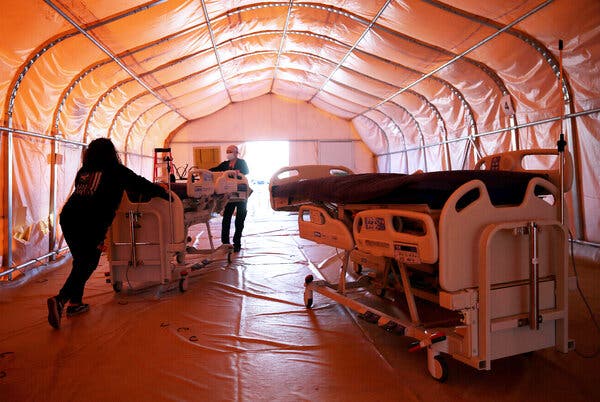Advertisement
Supported by
How the United States Beat the Variants, for Now
The country has managed to avoid a variant-fueled spike in coronavirus cases. Scientists say we were lucky.

Carl Zimmer and
On Dec. 29, a National Guardsman in Colorado became the first known case in the United States of a contagious new variant of the coronavirus.
The news was unsettling. The variant, called B.1.1.7, had roiled Britain, was beginning to surge in Europe and threatened to do the same in the United States. And although scientists didn’t know it yet, other mutants were also cropping up around the country. They included variants that had devastated South Africa and Brazil and that seemed to be able to sidestep the immune system, as well as others homegrown in California, Oregon and New York.
This mélange of variants could not have come at a worse time. The nation was at the start of a post-holiday surge of cases that would dwarf all previous waves. And the distribution of powerful vaccines made by Moderna and Pfizer-BioNTech was botched by chaos and miscommunication. Scientists warned that the variants — and B.1.1.7 in particular — might lead to a fourth wave, and that the already strained health care system might buckle.
That didn’t happen. B.1.1.7 did become the predominant version of the virus in the United States, now accounting for nearly three-quarters of all cases. But the surge experts had feared ended up a mere blip in most of the country. The nationwide total of daily new cases began falling in April and has now dropped more than 85 percent from the horrific highs of January.
“It’s pretty humbling,” said Kristian Andersen, a virologist at Scripps Research in La Jolla, Calif. “We could actually do a lot better than I had expected.”
Dr. Andersen and other virus watchers still see variants as a potential source of trouble in the months to come — particularly one that has battered Brazil and is growing rapidly in 17 U.S. states. But they are also taking stock of the past few months to better understand how the nation dodged the variant threat.
Experts point to a combination of factors — masks, social distancing and other restrictions, and perhaps a seasonal wane of infections — that bought crucial time for tens of millions of Americans to get vaccinated. They also credit a good dose of serendipity, as B.1.1.7, unlike some of its competitors, is powerless against the vaccines.
“I think we got lucky, to be honest,” said Nathan Grubaugh, an epidemiologist at Yale University. “We’re being rescued by the vaccine.”
After B.1.1.7 emerged at the end of December, new variants with combinations of troubling mutations came to light. Scientists fretted about how the competition between the variants might play out.

In January, researchers in California discovered a variant with 10 mutations that was growing more common there and had drifted into other states. Laboratory experiments suggested that the variant could dodge an antibody treatment that had worked well against previous forms of the virus, and that it was perhaps also more contagious.
In the months that have followed, the United States has drastically improved its surveillance of how the variants mutate. Last week more than 28,800 virus genomes, almost 10 percent of all positive test cases, were uploaded to an international online database called GISAID. That clearer picture has enabled scientists to watch how the mutants compete.
The California variant turned out to be a weak competitor, and its numbers dropped sharply in February and March. It is still prevalent in parts of Northern California, but it has virtually disappeared from southern parts of the state and never found a foothold elsewhere in the country. By April 24, it accounted for just 3.2 percent of all virus samples tested in the country, as B.1.1.7 soared to 66 percent.
“B.1.1.7 went in for the knockout, and it’s like, ‘Bye bye, California variant,’” Dr. Andersen said.
On the other side of the country, researchers reported in February that a variant called B.1.526 was spreading quickly in New York and appeared to be a formidable adversary for B.1.1.7. By February, each of those variants had grown to about 35 percent of the samples collected by Dr. Grubaugh’s lab in Connecticut. But B.1.1.7 came out on top.
In fact, B.1.1.7 seems to have the edge over nearly every variant identified so far. At a congressional hearing on Tuesday, Dr. Rochelle P. Walensky, the director of the Centers for Disease Control and Prevention, said B.1.1.7 made up 72 percent of cases in the country.
“We’re really seeing B.1.1.7 pushing out other variants decisively,” said Emma Hodcroft, an epidemiologist at the University of Bern.
The variants identified in California and New York turned out to be only moderately more contagious than older versions of the virus, and much of their initial success may have been luck. The overall boom in cases last fall amplified what might otherwise have gone undetected.
It’s unclear what gives B.1.1.7 an edge over the others. “Is it the greatest of all the variants? It’s just really hard to say right now,” said Angela Rasmussen, a virologist at the University of Saskatchewan’s Vaccine and Infectious Disease Organization. “We need more research to figure out more about what all of these combinations of mutations are doing.” Some answers may come from California, where researchers are staging a head-to-head competition in a lab, injecting mice with a cocktail of B.1.1.7 and six other variants.
“The idea is to see which one will win out,” said Dr. Charles Chiu, a virologist at the University of California, San Francisco, who was the first scientist to discover the California variant.
In Michigan, one of the few states that saw the predicted surge in cases this spring, B.1.1.7 found a hook in younger people who were returning to schools and playing contact sports.
“Because it’s more transmissible, the virus finds cracks in behavior that normally wouldn’t have been as much of a problem,” said Emily Martin, an epidemiologist at the University of Michigan.
But in the rest of the country, people naturally became more cautious when confronted with the horrifying toll of the virus after the holidays. B.1.1.7 is thought to be about 60 percent more contagious than previous forms of the virus, but its mode of spread is no different. Most states had at least partial restrictions on indoor dining and instituted mask mandates.
“B.1.1.7 is more transmissible, but it can’t jump through a mask,” Dr. Hodcroft said. “So we can still stop its spread.”
But other experts are still discomfited by how much the virus seems to have defied predictions.
“I can’t necessarily ascribe it just to behavior,” said Sarah Cobey, an evolutionary biologist at the University of Chicago. Respiratory viruses sometimes go through seasonal cycles, but it’s not clear why the coronavirus’s cycle would have caused it to decline in the middle of winter. “That makes me feel maybe even more ignorant,” she said.
Also puzzling is why variants that pummeled other countries have not yet spread widely in the United States. B.1.351 rapidly dominated South Africa and some other African countries late last year. It was first reported in the United States on Jan. 28, but still accounts for only 1 percent of cases. That may be because it can’t get ahead of the fast-spreading B.1.1.7.
“I think that is because it doesn’t really have much transmission advantage,” said William Hanage, an epidemiologist at the Harvard T.H. Chan School of Public Health.
P.1, a variant that is ravaging Brazil, got off to a slow start in the United States but is now estimated to make up more than 10 percent of the country’s cases.
“I believe it is a matter of time before the P.1 variant becomes one of the most prevalent in the U.S.A.,” warned Dr. André Ricardo Ribas Freitas, a medical epidemiologist at Faculdade São Leopoldo Mandic in Brazil.
Still, Nels Elde, an evolutionary biologist at the University of Utah, said the events of the past four months raised questions about whether it was worth fretting over different variants, rather than focusing on the behaviors that can rein in all of them.
“We’re splitting hairs between a handful of mutations here and there, we’ve lost some perspective,” he said. “It’s catnip for a curious mind.”
The United States also has an ample supply of powerful vaccines that make variants more an academic concern than a cause of worry for the average person. The vaccines may be slightly less effective against the variants identified in South Africa and Brazil, but they prevent severe disease from all known variants.
It’s not impossible the situation could worsen. Only about 35 percent of people in the United States have been fully immunized, and the protection from the vaccines may wane by the winter. No one knows how variants emerging in other parts of the world, like one that has come to prominence in India and is circulating at low levels in the United States, will behave here. And yet more variants will inevitably arise in places where the virus is rampant, Dr. Cobey warned: “There’s a lot of evolution to happen yet.”
Advertisement


